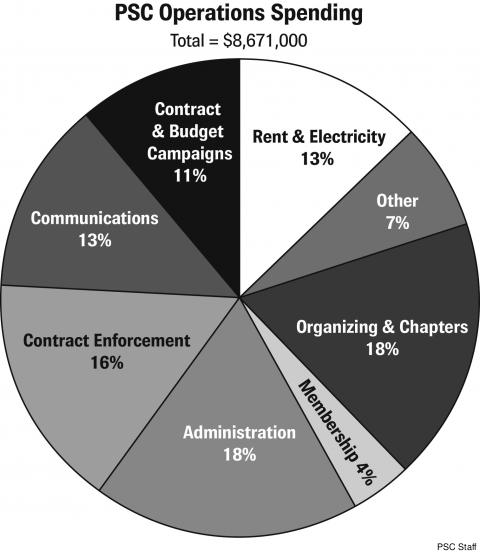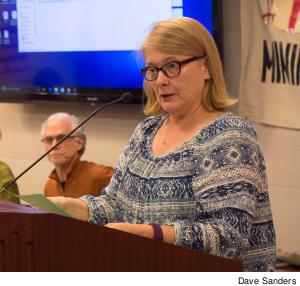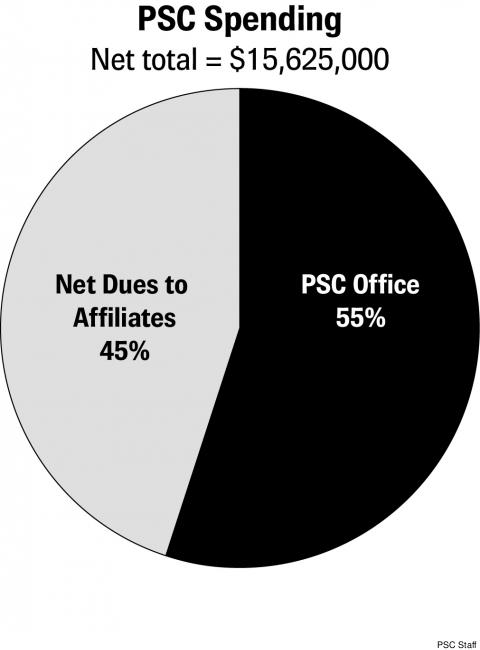
“The PSC is an organizing-focused, member-driven labor union, and our budget reflects our priorities,” explained PSC Treasurer Sharon Persinger. “Our revenue comes almost entirely from members’ dues, and we use every penny to build the union’s power. By pooling our individual dues, we generate collective power. Our dues give the PSC the financial resources to win higher salaries, improve our benefits and defend our jobs.”
Simply put, a primary part of any union’s strength is the health of its operating budget, and the PSC is not an exception. Union dues and agency shop fees fund the budget for all of the things that make the PSC strong: rent for the central office (including the union hall), signs, this newspaper, buses for lobbying trips to Albany and, of course, the staff members such as organizers, grievance counselors and contract enforcement coordinators.
CRITICAL MOMENT
In the face of the attacks on organized labor, it is more important than ever that members be able to see and understand how the PSC budget is broken down.
A closer look at the annual PSC budget shows that the bulk of the union’s net income is spent on the staff and materials needed to increase our collective power. Of the income the PSC spends directly on its own operations, roughly equal shares go to organizing, enforcing the contract, providing member services through administrative functions, like membership, and campaigns for negotiating and winning contract improvements and for increased public funding for CUNY. Almost half of the union’s income goes to support PSC’s labor affiliates to increase the union’s power at the city, state and national level.
This review analyzes PSC’s 2016-17 budget, a typical year as compared to the current fiscal year. This year, the 2017-18 projected budget reflects planning for the impact of the Supreme Court case Janus v. AFSCME, expected to be handed down this summer.
PSC SPENDING
The annual PSC Budget and monthly PSC Financial Statements are reviewed and approved by members’ elected representatives in the union’s Delegate Assembly.
PSC’s projected spending for last year totaled about $8.671 million. Union spending is illustrated in the large pie chart. Nearly 60 percent of spending went to the categories that obviously relate to building power for PSC members: 18 percent on Organizing and Building Chapters; 17 percent on Contract Enforcement; 13 percent on Communications (Clarion, the website, press releases and advertising); and 12 percent on Contract and Budget Campaigns. Last budget year, 9/16-8/17, the union finally had a contract in place at CUNY, so more effort went into contract implementation than to winning a new contract. Even so, the union waged an energetic fight in Albany during winter 2017 for Maintenance of Effort funding for CUNY.
 |
The remaining 42 percent of PSC spending went to rent – including the PSC Union Hall – and physical operations, like utilities, computer and copying equipment and maintenance, as well as insurance, accounting, office supplies, chapter elections, and administrative operations to keep the union office and its support for chapters working effectively. Managing membership records and databases is a critical part of the union’s work and accounts for 4 percent of spending.
PSC is a member-funded organization. 97.7 percent of revenues ($15.245 million) comes from dues and fees paid by members of the PSC bargaining unit covered by the CUNY contract. The balance comes from dues from Retirees and Associate Members ($207,000) and dues and fees paid by bargaining unit members covered by the Research Foundation contracts ($150,000). Other sources of revenue are rent from PSC subletting a portion of its office space to the Welfare Fund and returns from the investment of its Reserve Fund. PSC received one time dues/fees on the contractual bonus paid in October 2016 and on the retroactive salary increases paid in January 2017, but those funds (over $3 million) went into the union’s Reserve Fund and are not reflected in this budget.
AFFILIATE COSTS
Payments to our national and state affiliates, American Federation of Teachers (AFT) and New York State United Teachers (NYSUT), were budgeted at $10.6 million last year, based on formulas applied to the head count of PSC bargaining unit members. NYSUT dues are $7.1 million and AFT dues are $3.5 million. Dues to other affiliated organizations, like the Municipal Labor Committee, the municipal union coalition that bargains health care, are only $300,000.
Reimbursements from NYSUT and AFT are spent in several of the functional categories of the spending pie chart. The second pie chart shows the net payment to the national and state affiliates, 45 percent of PSC’s total spending budget. Of the $7.1 million paid to NYSUT, PSC received $3.7 million in reimbursements. So about half of the dues that the PSC pays to NYSUT is returned to the PSC as reimbursement. AFT reimburses the PSC for organizing and American Association of University Professors dues. For 2016-17 the total reimbursement was $300,000, so net dues to AFT were $3.2 million. In prior years, AFT has provided one time support for special projects, like communications funding for the contract campaign.
The budgeting process involves thoughtfully allocating funding for staff and resources to build power for the PSC time while at the same time supporting members’ activism on important issues and maintaining the flexibility to respond to management’s or government’s actions over a given year. PSC’s elected delegates’ ongoing involvement in budget decision-making is critical because the budget is essentially a statement of the union’s political strategies for building power.

